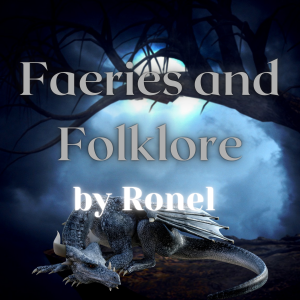Episode 31: Power Players of Faerie: Faery Queen
The folklore of the Faery Queen in a nutshell, how I reimagined her for my writing, and her title translated into Afrikaans.
Written and narrated by Ronel Janse van Vuuren.
Copyright 2022 Ronel Janse van Vuuren — All rights reserved.
Learn more about the Faery Queen here.
Get the transcript here.
Music: Secrets by David Fesliyan (FesliyanStudios.com) and Dramatic Heartbeat by FesliyanStudios.com
Transcript
You’re listening to the Faeries and Folklore podcast by Ronel.
I’m dark fantasy author Ronel Janse van Vuuren. With nearly a decade of digging around in dusty folklore books, researching creatures of imagination that ignited my curiosity, I’m here to share the folklore in a nutshell and how I reimagined it for my writing in an origin of the fae.
This is the Faeries and Folklore podcast.
Hi, I’m your host Ronel Janse van Vuuren. You can just call me Ronel. In today’s episode, we’re continuing our exploration of the fae realm.
This episode is brought to you by my book Once… Tales, Myths and Legends of Faerie available in eBook, audiobook and paperback. Learn more at ronelthemythmaker.com/my-books.
We’re continuing our exploration of the power players of Faerie.
Today’s Faery: Faery Queen
Folklore in a Nutshell by Ronel
The Faery Queen has always been this powerful, otherworldly beauty cloaked in mystery and whispers. Not a lot can be found in folklore about her, but what is obvious is that she goes by many names and can be found across the globe.
In Irish folklore, Aoibheall, is the queen of the fae. Her name means “beauty” or “burning fire”, depending on how old you think her name is. She is a favourite in Irish literature.
Mab is the faery queen in English folklore and makes her appearance in sixteenth and seventeenth century literature.
Titania is also the faery queen in English folklore thanks to Shakespeare’s “A Midsummer Night’s Dream”.
There are other named faery queens, but most I cannot even fathom how to pronounce – and I daren’t mess it up as faery queens are most volatile where it comes to courtly manners and being respectful of that all-important name, as there is power in a name.
Faerie is almost always said to be ruled by a queen. Though there are many named fairy kings, they only rule small kingdoms, not the entirety of Faerie.
Though faery queens are always beautiful, powerful, and seemingly gracious – they are still fae and still have the propensity for cruelty, and thus their capricious nature should never be forgotten. Even if Faerie seems to favour girl-power.
And now for my interpretation of the fae in an Origin of the Fae: the faery queen
Formal name: Queen Andromeda (used to seal compacts, curses, etc. There’s power in a name.).
Known as: Mae.
Known love-interest: Jamie MacKinnion, leader of the Galno, laird of clan Kinnion.
Weaknesses: none known.
Mae is the all-powerful queen of the fae. Though she shares the responsibility of Faerie and all fae with the Dark King, it is on her mercy fae (and others) fall when they have transgressed. She makes the rules; she enforces the rules (sending the Assassin or the Seelie Knights after the perpetrators).
Only the Assassin, the Dark King and the Cù Sìth can rival her powers. Even Ankou, King of the Dead, defers to her.
She can be volatile, merciful, caring and careless depending on her mood. The Rift was caused during one of her careless moments.
She is Faerie. Everything lives and dies by her whim. Everything comes into being or disappears at her command. After the Rift that divided Faerie, she no longer has such power over the Dark Lands belonging to the Unseelie Court and the Dark King.
When she decides to interfere in the Mortal Realm it is rarely a whim: she had foreseen something in her waterfall that is the Eye of Time, and it had most likely been confirmed by one of her Seers or even the Fates.
Mae is a powerful, independent woman in charge of a whole race of beings. It is her job to make sure that peace prevails between Man and Fae, to make sure the Dark King doesn’t do more damage than he already did by creating the Rift and the Labyrinth, and that everyone survives the unexpected.
As a little bonus, let’s look at the translation of Faery Queen into Afrikaans: Feëkoningin.
I hope that you’ve enjoyed this episode of the faeries and folklore podcast and that you’ve learned something new about faeries.
Remember that you can get a transcript of this episode in the description. If you’re new to the podcast, why not go and grab your free copy of Unseen, the second book in the Faery Tales series, on my website ronelthemythmaker.com? Loads of folklore, magic and danger await! Take care!
Available at
Audible | Podbean | Google Podcasts | Amazon Music | Spotify | Youtube | iHeart Radio | Player FM | Listen Notes | Apple Podcasts | TuneIn
You can now support my time in producing the podcast (researching, writing and everything else involved) by buying me a coffee. This can be a once-off thing, or you can buy me coffee again in the future at your discretion.
Want a taste of my writing? Sign up to my newsletter and get your free copy of Unseen, Faery Tales #2.


No-one writes about the fae like Ronel Janse van Vuuren.





1 thought on “The Faeries and Folklore Podcast by Ronel: Faery Queen #podcast #faeries #folklore”